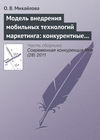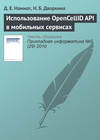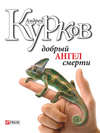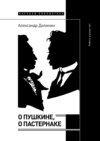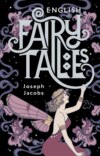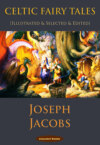Читать книгу: «Celtic Fairy Tales», страница 15
XIV. JACK AND HIS COMRADES
Source.—Kennedy's Legendary Fictions of the Irish Celts.
Parallels.—This is the fullest and most dramatic version I know of the Grimm's "Town Musicians of Bremen" (No. 27). I have given an English (American) version in my English Fairy Tales, No. 5, in the notes to which would be found references to other versions known in the British Isles (e.g., Campbell, No. 11) and abroad. Cf. remarks on No. vi.
XV. SHEE AN GANNON AND GRUAGACH GAIRE
Source.—Curtin, Myths and Folk-Lore of Ireland, p. 114 seq. I have shortened the earlier part of the tale, and introduced into the latter a few touches from Campbell's story of "Fionn's Enchantment," in Revue Celtique, t. i., 193 seq.
Parallels.—The early part is similar to the beginning of "The Sea-Maiden" (No. xvii., which see). The latter part is practically the same as the story of "Fionn's Enchantment," just referred to. It also occurs in MacInnes' Tales, No. iii., "The King of Albainn" (see Mr. Nutt's notes, 454). The head-crowned spikes are Celtic, cf. Mr. Nutt's notes (MacInnes' Tales, 453).
Remarks.—Here again we meet the question whether the folk-tale precedes the hero-tale about Finn or was derived from it, and again the probability seems that our story has the priority as a folk-tale, and was afterwards applied to the national hero, Finn. This is confirmed by the fact that a thirteenth century French romance, Conte du Graal, has much the same incidents, and was probably derived from a similar folk-tale of the Celts. Indeed, Mr. Nutt is inclined to think that the original form of our story (which contains a mysterious healing vessel) is the germ out of which the legend of the Holy Grail was evolved (see his Studies in the Holy Grail, p. 202 seq.).
XVI. THE STORY-TELLER AT FAULT
Source.—Griffin's Tales from a Jury-Room, combined with Campbell, No. xvii. c, "The Slim Swarthy Champion."
Parallels.—Campbell gives another variant, l.c. i. 318. Dr. Hyde has an Irish version of Campbell's tale written down in 1762, from which he gives the incident of the air-ladder (which I have had to euphemise in my version) in his Beside the Fireside, p. 191, and other passages in his Preface. The most remarkable parallel to this incident, however, is afforded by the feats of Indian jugglers reported briefly by Marco Polo, and illustrated with his usual wealth of learning by the late Sir Henry Yule, in his edition, vol. i. p. 308 seq. The accompanying illustration (reduced from Yule) will tell its own tale: it is taken from the Dutch account of the travels of an English sailor, E. Melton, Zeldzaame Reizen, 1702, p. 468. It tells the tale in five acts, all included in one sketch. Another instance quoted by Yule is still more parallel, so to speak. The twenty-third trick performed by some conjurors before the Emperor Jahangueir (Memoirs, p. 102) is thus described: "They produced a chain of 50 cubits in length, and in my presence threw one end of it towards the sky, where it remained as if fastened to something in the air. A dog was then brought forward, and being placed at the lower end of the chain, immediately ran up, and, reaching the other end, immediately disappeared in the air. In the same manner a hog, a panther, a lion, and a tiger were successively sent up the chain." It has been suggested that the conjurors hypnotise the spectators, and make them believe they see these things. This is practically the suggestion of a wise Mohammedan, who is quoted by Yule as saying, "Wallah! 'tis my opinion there has been neither going up nor coming down; 'tis all hocus-pocus," hocus-pocus being presumably the Mohammedan term for hypnotism.
Remarks.—Dr. Hyde (l.c. Pref. xxix.) thinks our tale cannot be older than 1362, because of a reference to one O'Connor Sligo which occurs in all its variants; it is, however, omitted in our somewhat abridged version. Mr Nutt (ap. Campbell, The Fians, Introd. xix.) thinks that this does not prevent a still earlier version having existed. I should have thought that the existence of so distinctly Eastern a trick in the tale, and the fact that it is a framework story (another Eastern characteristic), would imply that it is a rather late importation, with local allusions superadded (cf. notes on "Conal Yellowclaw," No v.)
The passages in verse from pp 137, 139, and the description of the Beggarman, pp. 136, 140, are instances of a curious characteristic of Gaelic folk-tales called "runs." Collections of conventional epithets are used over and over again to describe the same incident, the beaching of a boat, sea-faring, travelling and the like, and are inserted in different tales. These "runs" are often similar in both the Irish and the Scotch form of the same tale or of the same incident. The volumes of Waifs and Strays contain numerous examples of these "runs," which have been indexed in each volume. These "runs" are another confirmation of my view that the original form of the folk-tale was that of the Cante-fable (see note on "Connla" and on "Childe Rowland" in English Fairy Tales).
XVII. SEA-MAIDEN
Source.—Campbell, Pop. Tales, No. 4. I have omitted the births of the animal comrades and transposed the carlin to the middle of the tale. Mr. Batten has considerately idealised the Sea-Maiden in his frontispiece. When she restores the husband to the wife in one of the variants, she brings him out of her mouth! "So the sea-maiden put up his head (Who do you mean? Out of her mouth to be sure. She had swallowed him)."
Parallels.—The early part of the story occurs in No. xv., "Shee an Gannon," and the last part in No. xix., "Fair, Brown, and Trembling" (both from Curtin), Campbell's No. 1. "The Young King" is much like it; also MacInnes' No. iv., "Herding of Cruachan" and No. viii., "Lod the Farmer's Son." The third of Mr. Britten's Irish folk-tales in the Folk-Lore Journal is a Sea-Maiden story. The story is obviously a favourite one among the Celts. Yet its main incidents occur with frequency in Continental folk-tales. Prof. Köhler has collected a number in his notes on Campbell's Tales in Orient und Occident, Bnd. ii. 115-8. The trial of the sword occurs in the saga of Sigurd, yet it is also frequent in Celtic saga and folk-tales (see Mr. Nutt's note, MacInnes' Tales, 473, and add. Curtin, 320). The hideous carlin and her three giant sons is also a common form in Celtic. The external soul of the Sea-Maiden carried about in an egg, in a trout, in a hoodie, in a hind, is a remarkable instance of a peculiarly savage conception which has been studied by Major Temple, Wide-awake Stories, 404-5; by Mr. E. Clodd, in the "Philosophy of Punchkin," in Folk-Lore Journal, vol. ii., and by Mr. Frazer in his Golden Bough, vol. ii.
Remarks.—As both Prof. Rhys (Hibbert Lect., 464) and Mr. Nutt (MacInnes' Tales, 477) have pointed out, practically the same story (that of Perseus and Andromeda) is told of the Ultonian hero, Cuchulain, in the Wooing of Emer, a tale which occurs in the Book of Leinster, a MS. of the twelfth century, and was probably copied from one of the eighth. Unfortunately it is not complete, and the Sea-Maiden incident is only to be found in a British Museum MS. of about 1300. In this Cuchulain finds that the daughter of Ruad is to be given as a tribute to the Fomori, who, according to Prof. Rhys, Folk-Lore, ii. 293, have something of the night_mare_ about their etymology. Cuchulain fights three of them successively, has his wounds bound up by a strip of the maiden's garment, and then departs. Thereafter many boasted of having slain the Fomori, but the maiden believed them not till at last by a stratagem she recognises Cuchulain. I may add to this that in Mr. Curtin's Myths, 330, the threefold trial of the sword is told of Cuchulain. This would seem to trace our story back to the seventh or eighth century and certainly to the thirteenth. If so, it is likely enough that it spread from Ireland through Europe with the Irish missions (for the wide extent of which see map in Mrs. Bryant's Celtic Ireland). The very letters that have spread through all Europe except Russia, are to be traced to the script of these Irish monks: why not certain folk-tales? There is a further question whether the story was originally told of Cuchulain as a hero-tale and then became departicularised as a folk-tale, or was the process vice versa. Certainly in the form in which it appears in the Tochmarc Emer it is not complete, so that here, as elsewhere, we seem to have an instance of a folk-tale applied to a well-known heroic name, and becoming a hero-tale or saga.
XVIII. LEGEND OF KNOCKMANY
Source.—W. Carleton, Traits and Stories of the Irish Peasantry.
Parallels.—Kennedy's "Fion MacCuil and the Scotch Giant," Legend. Fict., 203-5.
Remarks.—Though the venerable names of Finn and Cucullin (Cuchulain) are attached to the heroes of this story, this is probably only to give an extrinsic interest to it. The two heroes could not have come together in any early form of their sagas, since Cuchulain's reputed date is of the first, Finn's of the third century A.D. (cf. however, MacDougall's Tales, notes, 272). Besides, the grotesque form of the legend is enough to remove it from the region of the hero-tale. On the other hand, there is a distinct reference to Finn's wisdom-tooth, which presaged the future to him (on this see Revue Celtique, v. 201, Joyce, Old Celt. Rom., 434-5, and MacDougall, l.c. 274). Cucullin's power-finger is another instance of the life-index or external soul, on which see remarks on Sea-Maiden. Mr. Nutt informs me that parodies of the Irish sagas occur as early as the sixteenth century, and the present tale may be regarded as a specimen.
XIX. FAIR, BROWN, AND TREMBLING
Source.—Curtin, Myths, &c., of Ireland, 78 seq.
Parallels.—The latter half resembles the second part of the Sea-Maiden (No. xvii.), which see. The earlier portion is a Cinderella tale (on which see the late Mr. Ralston's article in Nineteenth Century, Nov. 1879, and Mr. Lang's treatment in his Perrault). Miss Roalfe Cox is about to publish for the Folk-Lore Society a whole volume of variants of the Cinderella group of stories, which are remarkably well represented in these isles, nearly a dozen different versions being known in England, Ireland, and Scotland.
XX. JACK AND HIS MASTER
Source.—Kennedy, Fireside Stories of Ireland, 74-80, "Shan an Omadhan and his Master."
Parallels.—It occurs also in Campbell, No. xlv., "Mac a Rusgaich." It is a European droll, the wide occurrence of which—"the loss of temper bet" I should call it—is bibliographised by M. Cosquin, l.c. ii. 50 (cf. notes on No. vi.).
XXI. BETH GELLERT
Source.—I have paraphrased the well-known poem of Hon. W. R. Spencer, "Beth Gêlert, or the Grave of the Greyhound," first printed privately as a broadsheet in 1800 when it was composed ("August 11, 1800, Dolymalynllyn" is the colophon). It was published in Spencer's Poems, 1811, pp. 78-86. These dates, it will be seen, are of importance. Spencer states in a note: "The story of this ballad is traditionary in a village at the foot of Snowdon where Llewellyn the Great had a house. The Greyhound named Gêlert was given him by his father-in-law, King John, in the year 1205, and the place to this day is called Beth-Gêlert, or the grave of Gêlert." As a matter of fact, no trace of the tradition in connection with Bedd Gellert can be found before Spencer's time. It is not mentioned in Leland's Itinerary, ed. Hearne, v. p. 37 ("Beth Kellarth"), in Pennant's Tour (1770), ii. 176, or in Bingley's Tour in Wales (1800). Borrow in his Wild Wales, p. 146, gives the legend, but does not profess to derive it from local tradition.
Parallels.—The only parallel in Celtdom is that noticed by Croker in his third volume, the legend of Partholan who killed his wife's greyhound from jealousy: this is found sculptured in stone at Ap Brune, co. Limerick. As is well known, and has been elaborately discussed by Mr. Baring-Gould (Curious Myths of the Middle Ages, p. 134 seq.), and Mr. W. A. Clouston (Popular Tales and Fictions, ii. 166, seq.), the story of the man who rashly slew the dog (ichneumon, weasel, &c.) that had saved his babe from death, is one of those which have spread from East to West. It is indeed, as Mr. Clouston points out, still current in India, the land of its birth. There is little doubt that it is originally Buddhistic: the late Prof. S. Beal gave the earliest known version from the Chinese translation of the Vinaya Pitaka in the Academy of Nov. 4, 1882. The conception of an animal sacrificing itself for the sake of others is peculiarly Buddhistic; the "hare in the moon" is an apotheosis of such a piece of self-sacrifice on the part of Buddha (Sasa Jataka). There are two forms that have reached the West, the first being that of an animal saving men at the cost of its own life. I pointed out an early instance of this, quoted by a Rabbi of the second century, in my Fables of Aesop, i. 105. This concludes with a strangely close parallel to Gellert; "They raised a cairn over his grave, and the place is still called The Dog's Grave." The Culex attributed to Virgil seems to be another variant of this. The second form of the legend is always told as a moral apologue against precipitate action, and originally occurred in The Fables of Bidpai in its hundred and one forms, all founded on Buddhistic originals (cf. Benfey, Pantschatantra, Einleitung, §201). [Footnote: It occurs in the same chapter as the story of La Perrette, which has been traced, after Benfey, by Prof. M. Müller in his "Migration of Fables" (Sel. Essays, i. 500-74): exactly the same history applies to Gellert.] Thence, according to Benfey, it was inserted in the Book of Sindibad, another collection of Oriental Apologues framed on what may be called the Mrs. Potiphar formula. This came to Europe with the Crusades, and is known in its Western versions as the Seven Sages of Rome. The Gellert story occurs in all the Oriental and Occidental versions; e.g., it is the First Master's story in Wynkyn de Worde's (ed. G. L. Gomme, for the Villon Society.) From the Seven Sages it was taken into the particular branch of the Gesta Romanorum current in England and known as the English Gesta, where it occurs as c. xxxii., "Story of Folliculus." We have thus traced it to England whence it passed to Wales, where I have discovered it as the second apologue of "The Fables of Cattwg the Wise," in the Iolo MS. published by the Welsh MS. Society, p.561, "The man who killed his Greyhound." (These Fables, Mr. Nutt informs me, are a pseudonymous production probably of the sixteenth century.) This concludes the literary route of the Legend of Gellert from India to Wales: Buddhistic Vinaya Pitaka—Fables of Bidpai;—Oriental Sindibad;—Occidental Seven Sages of Rome;—"English" (Latin), Gesta Romanorum;—Welsh, Fables of Cattwg.
Remarks.—We have still to connect the legend with Llewelyn and with Bedd Gelert. But first it may be desirable to point out why it is necessary to assume that the legend is a legend and not a fact. The saving of an infant's life by a dog, and the mistaken slaughter of the dog, are not such an improbable combination as to make it impossible that the same event occurred in many places. But what is impossible, in my opinion, is that such an event should have independently been used in different places as the typical instance of, and warning against, rash action. That the Gellert legend, before it was localised, was used as a moral apologue in Wales is shown by the fact that it occurs among the Fables of Cattwg, which are all of that character. It was also utilised as a proverb: "Yr wy'n edivaru cymmaint a'r Gwr a laddodd ei Vilgi" ("I repent as much as the man who slew his greyhound"). The fable indeed, from this point of view, seems greatly to have attracted the Welsh mind, perhaps as of especial value to a proverbially impetuous temperament. Croker (Fairy Legends of Ireland, vol. iii. p. 165) points out several places where the legend seems to have been localised in place-names—two places, called "Gwal y Vilast" ("Greyhound's Couch"), in Carmarthen and Glamorganshire; "Llech y Asp" ("Dog's Stone"), in Cardigan, and another place named in Welsh "Spring of the Greyhound's Stone." Mr. Baring-Gould mentions that the legend is told of an ordinary tombstone, with a knight and a greyhound, in Abergavenny Church; while the Fable of Cattwg is told of a man in Abergarwan. So widespread and well known was the legend that it was in Richard III's time adopted as the national crest. In the Warwick Roll, at the Herald's Office, after giving separate crests for England, Scotland, and Ireland, that for Wales is given as figured in the margin, and blazoned "on a coronet in a cradle or, a greyhound argent for Walys" (see J. R. Planché, Twelve Designs for the Costume of Shakespeare's Richard III., 1830, frontispiece). If this Roll is authentic, the popularity of the legend is thrown back into the fifteenth century. It still remains to explain how and when this general legend of rash action was localised and specialised at Bedd Gelert: I believe I have discovered this. There certainly was a local legend about a dog named Gelert at that place; E. Jones, in the first edition of his Musical Relicks of the Welsh Bards, 1784, p. 40, gives the following englyn or epigram:
Claddwyd Cylart celfydd (ymlyniad)
Ymlaneau Efionydd
Parod giuio i'w gynydd
Parai'r dydd yr heliai Hydd;
which he Englishes thus:
The remains of famed Cylart, so faithful and good,
The bounds of the cantred conceal;
Whenever the doe or the stag he pursued
His master was sure of a meal.
No reference was made in the first edition to the Gellert legend, but in the second edition of 1794, p. 75, a note was added telling the legend, "There is a general tradition in North Wales that a wolf had entered the house of Prince Llewellyn. Soon after the Prince returned home, and, going into the nursery, he met his dog Kill-hart, all bloody and wagging his tail at him; Prince Llewellyn, on entering the room found the cradle where his child lay overturned, and the floor flowing with blood; imagining that the greyhound had killed the child, he immediately drew his sword and stabbed it; then, turning up the cradle, found under it the child alive, and the wolf dead. This so grieved the Prince, that he erected a tomb over his faithful dog's grave; where afterwards the parish church was built and goes by that name—Bedd Cilhart, or the grave of Kill-hart, in Carnarvonshire. From this incident is elicited a very common Welsh proverb [that given above which occurs also in 'The Fables of Cattwg;' it will be observed that it is quite indefinite.]" "Prince Llewellyn ab Jorwerth married Joan, [natural] daughter of King John, by Agatha, daughter of Robert Ferrers, Earl of Derby; and the dog was a present to the prince from his father-in-law about the year 1205." It was clearly from this note that the Hon. Mr. Spencer got his account; oral tradition does not indulge in dates Anno Domini. The application of the general legend of "the man who slew his greyhound" to the dog Cylart, was due to the learning of E. Jones, author of the Musical Relicks. I am convinced of this, for by a lucky chance I am enabled to give the real legend about Cylart, which is thus given in Carlisle's Topographical Dictionary of Wales, s.v., "Bedd Celert," published in 1811, the date of publication of Mr. Spencer's Poems. "Its name, according to tradition, implies The Grave of Celert, a Greyhound which belonged to Llywelyn, the last Prince of Wales: and a large Rock is still pointed out as the monument of this celebrated Dog, being on the spot where it was found dead, together with the stag which it had pursued from Carnarvon," which is thirteen miles distant. The cairn was thus a monument of a "record" run of a greyhound: the englyn quoted by Jones is suitable enough for this, while quite inadequate to record the later legendary exploits of Gêlert. Jones found an englyn devoted to an exploit of a dog named Cylart, and chose to interpret it in his second edition, 1794, as the exploit of a greyhound with which all the world (in Wales) were acquainted. Mr. Spencer took the legend from Jones (the reference to the date 1205 proves that), enshrined it in his somewhat banal verses, which were lucky enough to be copied into several reading-books, and thus became known to all English-speaking folk.
It remains only to explain why Jones connected the legend with Llewelyn. Llewelyn had local connection with Bedd Gellert, which was the seat of an Augustinian abbey, one of the oldest in Wales. An inspeximus of Edward I. given in Dugdale, Monast. Angl., ed. pr. ii. 100a, quotes as the earliest charter of the abbey "Cartam Lewelin, magni." The name of the abbey was "Beth Kellarth"; the name is thus given by Leland, l.c., and as late as 1794 an engraving at the British Museum is entitled "Beth Kelert," while Carlisle gives it as "Beth Celert." The place was thus named after the abbey, not after the cairn or rock. This is confirmed by the fact of which Prof. Rhys had informed me, that the collocation of letters rt is un-Welsh. Under these circumstances it is not impossible, I think, that the earlier legend of the marvellous run of "Cylart" from Carnarvon was due to the etymologising fancy of some English-speaking Welshman who interpreted the name as Killhart, so that the simpler legend would be only a folk-etymology.
But whether Kellarth, Kelert, Cylart, Gêlert or Gellert ever existed and ran a hart from Carnarvon to Bedd Gellert or no, there can be little doubt after the preceding that he was not the original hero of the fable of "the man that slew his greyhound," which came to Wales from Buddhistic India through channels which are perfectly traceable. It was Edward Jones who first raised him to that proud position, and William Spencer who securely installed him there, probably for all time. The legend is now firmly established at Bedd Gellert. There is said to be an ancient air, "Bedd Gelert," "as sung by the Ancient Britons"; it is given in a pamphlet published at Carnarvon in the "fifties," entitled Gellert's Grave; or, Llewellyn's Rashness: a Ballad, by the Hon. W. R. Spencer, to which is added that ancient Welsh air, "Bedd Gelert," as sung by the Ancient Britons. The air is from R. Roberts' "Collection of Welsh Airs," but what connection it has with the legend I have been unable to ascertain. This is probably another case of adapting one tradition to another. It is almost impossible to distinguish palaeozoic and cainozoic strata in oral tradition. According to Murray's Guide to N. Wales, p. 125, the only authority for the cairn now shown is that of the landlord of the Goat Inn, "who felt compelled by the cravings of tourists to invent a grave." Some old men at Bedd Gellert, Prof. Rhys informs me, are ready to testify that they saw the cairn laid. They might almost have been present at the birth of the legend, which, if my affiliation of it is correct, is not yet quite 100 years old.
Покупайте книги и получайте бонусы в Литрес, Читай-городе и Буквоеде.
Участвовать в бонусной программе

